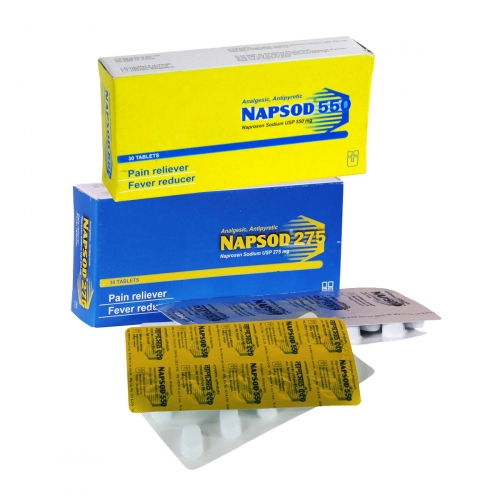ঔষধের বিস্তারিত বা বিকল্প ঔষধ জানতে ঔষধের নাম দিয়ে সার্চ দিন। যেমন- Napa বা Alatrol বা Amodis
Napsod 550mg
TabletNaproxen Sodium
Unimed Unihealth MFG. Ltd
Other Strength:
- Napsod 275mg
Alternative:

Napsod
Presentation
Napsod-275 tablet: Deep blue, oval shaped, film coated tablet; each tablet contains Naproxen sodium USP 275 mg equivalent to Naproxen 250 mg.
Napsod-550 tablet: Light blue scored, capsule shaped, film coated tablet; each tablet contains Naproxen sodium USP 550 mg equivalent to Naproxen 500mg.
Indications
Naproxen is a non-steroidal anti-inflammatory drug (NSAID) with analgesic and antipyretic properties. The sodium salt of Naproxen has been developed as a more rapidly absorbed formulation of naproxen for use as an analgesic. It is used in musculoskeletal and joint disorders such as ankylosing spondylitis, osteoarthritis and rheumatoid arthritis including juvenile chronic arthritis. It is also used in dysmenorrhoea, headache including migraine, post-operative pain, softtissue disorders, acute gout, and to reduce fever.
Dosage and administration
Management of pain, primary dysmenorrhea, and acute tendonitis and bursitis: the recommended starting dose is Naproxen Sodium 550 mg (one Napsod-550 tablet) followed by 550 mg (one Napsod-550 tablet) every 12 hours or 275 mg (one Napsod-275 tablet) every 6-8 hours as required. The initial total daily dose shoud not exceed 1375 mg of Naproxen Sodium. Thereafter, the total daily dose should not exceed 1100 mg of Naproxen Sodium. Acut Gout: The recommended starting dose is Naproxen Sodium 825 mg (three Napsod-275 tablets) follwed by 275 mg (one Napsod-275 tablet) every 8 hours until the attack has subsided. For the treatment of migraine: Naproxen Sodium 825 mg (three Napsod-275 tablets) can be given at the first symptom of an impending attack and, if necessary, this may be followed after at least half an hour by further dose of 275 to 550 mg (one Napsod-275 tablet or one Napsod-550 tablet) throughout the day to a total maximum daily dose of 1375 mg. For rheumatoid arthritis, Osteooarthritis and ankylosing spondylitis: Naproxen Sodium 275 mg to 550 mg (one Napsod-275 tablet or one Napsod-550 tablet) twice daily. Children over 5 years of age with juvenile chronic arthritis: A dose of 10mg per kg body-weight daily of Naproxen in 2 divided doses.
Contra-indications, warnings, etc.
Contra-indications: It is contra-indicated for those patients who are hypersensitive to Naproxen. It is also contra-indicated in patients in whom aspirin or other non-steroidal antiinflammatory/ analgesic drugs induce the syndrome of asthma, rhinitis, and nasal polyps.
Warnings: Risk of Gl ulceration, bleeding and perforation with NSAID therapy: Serious gastrointestinal toxicity such as bleeding, ulceration and perforation can occur at any time, with or without warning symptoms, in patients treated chronically with NSAID therapy.
Precautions: Renal effects: As with other non-steroidal anti- inflammatory drugs, long-term administration of naproxen to animal has resulted in renal papillary necrosis and other abnormal renal pathology. In humans, there have been reports of acute interstitial nephritis, hematuria, proteinuria and occasionally nephrotic syndrome associated with Naproxen-containing products and others NSAIDs since they have been marketed. Naproxen and its metabolites are eliminated primarily by the kidneys; therefore, the drug should be used with caution in patients with significantly impaired renal function, and the monitoring of serum creatinine and/or creatinine clearance is advised in these patients. Caution should be used if the drug is given to the patients with creatinine clearance of less than 20ml/min because accumulation of naproxen metabolites has been seen in such patients.
Hepatic effects: There have been a few reports of moderate to severe jaundice attributed to Naproxen.
Use in pregnancy and lactation: Most non-steroidal anti-inflammatory drugs may have an adverse effect on the fetus through their pharmacological properties. Naproxen causes a delay in parturition in animals and has been associated with premature closure of the ductus arteriosus and severe pulmonary hypertension in infants born to mothers taking Naproxen. The use of Naproxen in the first and third trimesters requires careful balancing of the benefits to the mother against the possible risks to the fetus. Naproxen is excreted in small amounts in the breast milk for nursing mothers. The amount of Naproxen distributed into breast milk is considered by some authorities to be too small to be harmful to a breast-fed infant although some manufacturers
recommend that breast feeding should be avoided during Naproxen therapy.
Drug interactions: Potentially hazardous interactions occur with warfarin, antihypertensives like atenolol, nicardipine, verapamil, furosemide, lithium and methotrexate. Other significant interaction also occurs with antacids, histamine H2 receptor antagonists like cimetidine, ranitidine & famotidine; phenytoin etc. The excretion of Naproxen is delayed by probenecidresulting in raised plasma concentration of Naproxen.
Side-effects: The following adverse reactions have been reported: Gastrointestinal: constipation, heartburn, abdominal pain, nausea, dyspepsia, diarrhoea, stomatitis. abnormal liver function test, colitis, gastrointestinal bleeding and/or perforation, hematemesis, jaundice, pancreatitis, melena, vomiting. Central nervous system: headache, dizziness, drowsiness, lightheadedness, vertigo, depression, dream abnormalities, inability to concentrate, insomnia, malaise, myalgia, muscle weakness. Dermatologic: itching (pruritus), skin eruptions, ecchymoses, sweating, purpura. Cardiovascular: edema, dyspnea, palpitations, General: thirst.
Pharmaceutical precautions
Store in a cool and dry place, protected from light.
Packaging quantities
Napsod -275 tablet: Carton containing 30 tablets in blisters.
Napsod -550 tablet: Carton containing 30 tablets in blisters.
এই পাতাটি ১৩১ বার দেখা হয়েছে
রাজডক কী?
ফ্রী সদস্য হোন Click Here
ডাক্তার হিসাবে যোগদান করতে Click Here
নার্স / টেকনোলজিস্ট হিসাবে যোগদান করতে Click Here
ফ্রী সদস্য হোন Click Here
ডাক্তার হিসাবে যোগদান করতে Click Here
নার্স / টেকনোলজিস্ট হিসাবে যোগদান করতে Click Here

